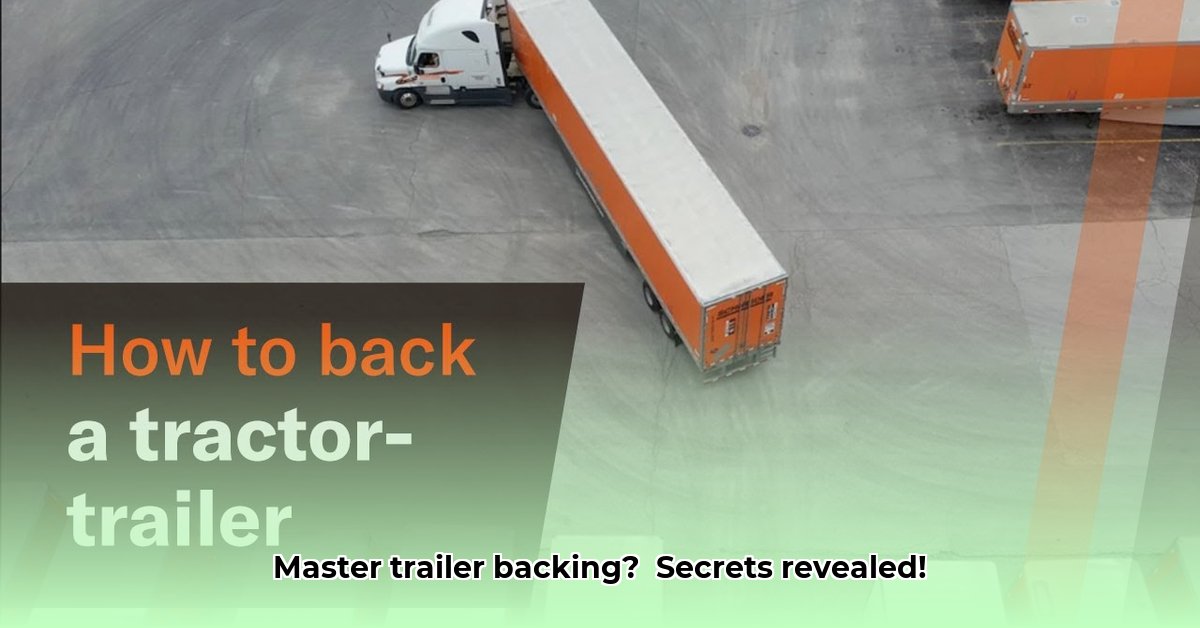
Understanding the Challenges and Building a Foundation
Backing a tractor-trailer presents unique challenges, demanding precision, spatial awareness, and effective communication. Blind spots, tight spaces, and unpredictable conditions contribute to the inherent risks. However, by mastering fundamental techniques and employing proven strategies, drivers can significantly enhance safety and efficiency. This guide provides a step-by-step approach to mastering this crucial skill. For more detailed visuals, check out this helpful guide.
The "Get Out And Look" (GOAL) Method: Your Primary Safety Net
Before initiating any backing maneuver, always employ the Get Out And Look (GOAL) method. This involves thoroughly inspecting your surroundings on foot before getting behind the wheel. Check for obstacles, potential hazards (pedestrians, other vehicles), and assess the available space. This pre-maneuver assessment is proactive risk mitigation; 90% of accidents could be averted with this step alone. Don't rush; take your time to fully understand the environment. Isn't safety worth the extra few seconds?
Mirror Usage and Blind Spot Awareness
Proper mirror adjustments are paramount. Your mirrors are your eyes in reverse, extending your field of vision. Ensure your mirrors provide maximum visibility, overlapping views to minimize blind spots. Remember, even with optimal mirror adjustment, blind spots will always exist. This is why the GOAL method is crucial; it compensates for where your mirrors fall short. Regularly check and adjust your mirrors to maintain optimal visibility - your effective visual field is key.
Step-by-Step Backing Techniques: Mastering Common Scenarios
This section details backing techniques for three common scenarios: straight-line backing, alley docking, and parallel parking.
1. Straight-Line Backing: The Fundamentals
- Initial Positioning: Position your rig to ensure a clear, unobstructed path for backing.
- Steering: Use small, incremental steering corrections. Avoid jerky movements; steer with precision and gradual adjustments.
- Observation: Continuously monitor your mirrors, scanning for obstacles and adjusting your course accordingly. Maintain a slow speed throughout.
- Speed Control: Maintain a very slow speed, using the slowest possible reverse gear. Speed is the enemy of precision.
2. Alley Docking: Precision and Communication
Alley docking requires a coordinated approach, integrating precision steering with effective spotter communication.
- Approach: Approach the dock at a slight angle (15-20 degrees), allowing for easier maneuvering.
- Steering: Make small steering corrections as you align with the dock. This is where a spotter's guidance is invaluable.
- Spotter Interaction: Establish clear hand signals and verbal communication with your spotter before starting. Their guidance is crucial in mitigating blind spots.
- Fine-Tuning: Expect minor adjustments as you near the dock. Gradual steering inputs will help perfect alignment.
3. Parallel Parking: The Test of Skill
Parallel parking requires more advanced spatial reasoning and precise maneuvering.
- Space Assessment: Assess available space before attempting to park. If the space is too tight, find an alternative location.
- Approach: Approach the parking space at a slight angle, maintaining a slow and controlled speed.
- Steering: Employ small, subtle steering corrections to align your rig during the process.
- Refinement: Multiple minor adjustments are often needed to perfectly align your truck in the space.
Enhancing Safety: Spotter Communication and Challenging Conditions
The Role of an Effective Spotter
A trained spotter significantly enhances safety. Establish clear, understood hand signals and verbal cues before starting any backing maneuver. Their guidance helps overcome blind spots and improves response time in potential hazards. A skilled spotter is your best safety asset.
Navigating Challenging Situations
Adverse weather and restricted spaces demand an adjusted approach. Reduce speed significantly, increase vigilance, and take extra time to assess the situation before proceeding. Never hesitate to stop and reassess if uncertainty arises.
Troubleshooting and Continuous Improvement
Common Problems and Solutions
- Jackknifing: Caused by oversteering or excessive speed. Focus on slower speeds and progressively smaller steering corrections.
- Trailer Swing: Often stems from uneven terrain or weight distribution. Ensure even weight distribution across axles.
The Continuous Learning Curve
Mastering tractor-trailer backing is an ongoing process, demanding regular practice and continuous learning. Regular training and review sessions are essential for skill refinement and accident prevention. Analyze each maneuver to identify areas for improvement - continuous learning is your key to success.
Key Takeaways: A Summary of Best Practices
- The GOAL method is not optional; it's your primary safety procedure.
- Proper mirror adjustment is crucial for maximizing visibility and minimizing blind spots.
- Effective spotter communication is essential for backing safely, especially in tight or challenging situations.
- Mastering different backing maneuvers requires consistent practice and skill refinement.
- Continuous learning and professional development are critical for maintaining safety and enhancing skills.
This guide provides a framework for safe and efficient tractor-trailer backing. Consistent application of these techniques, coupled with ongoing practice and professional development, will contribute to safer driving practices and enhanced operational efficiency.